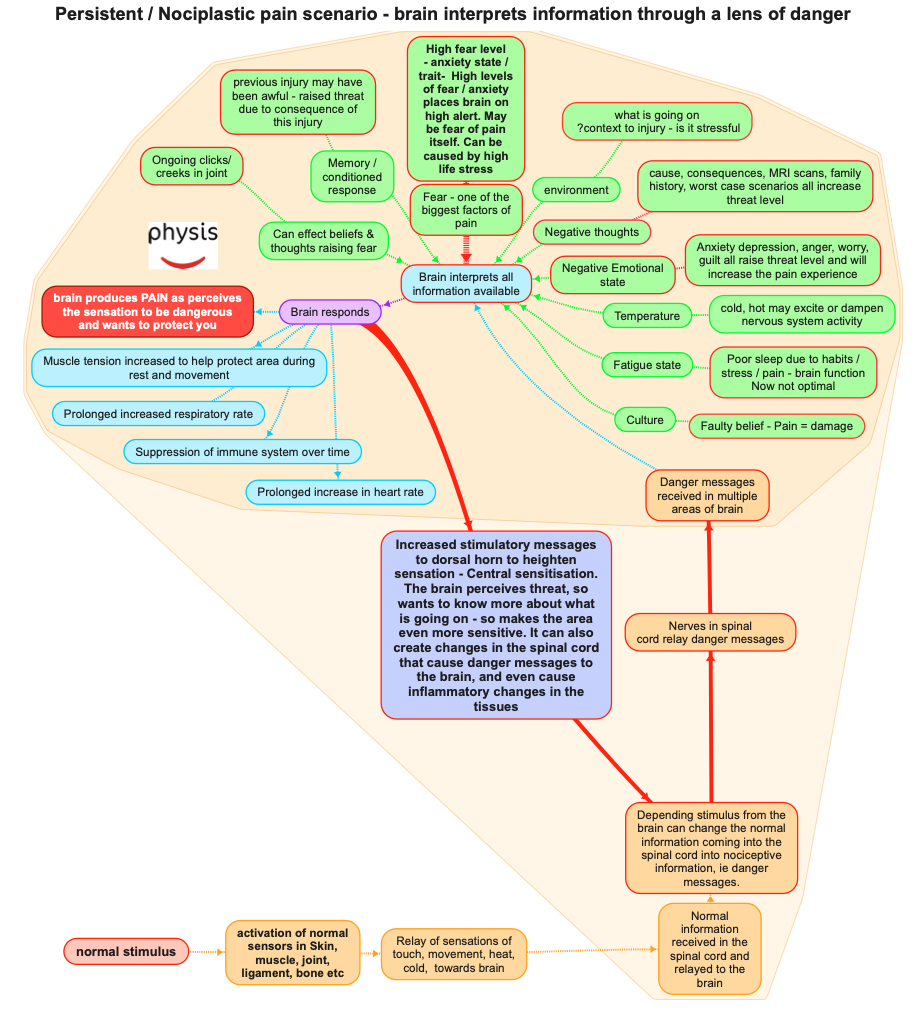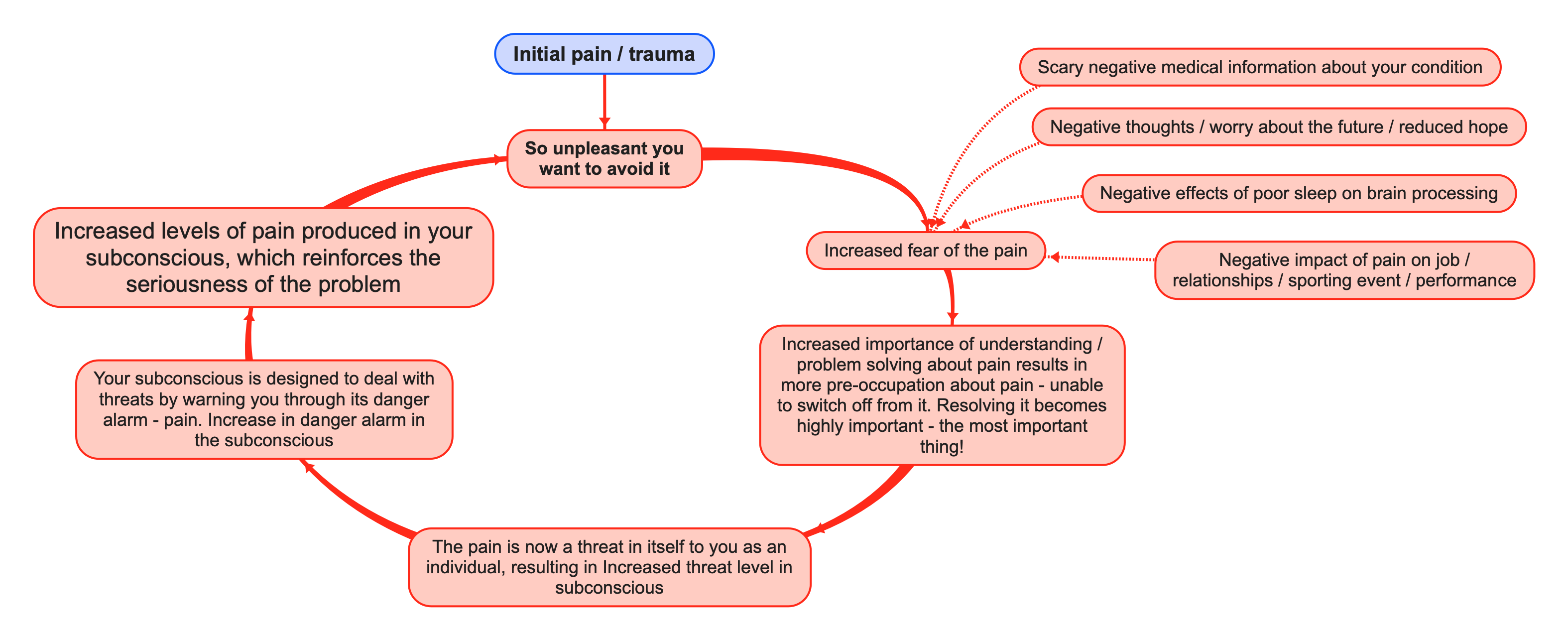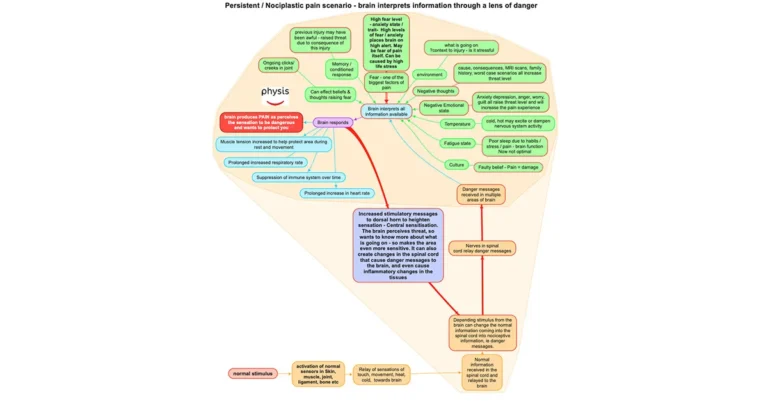When the pain system works well, it serves to protect us and it does a good job. If you injure yourself, the pain helps to restrict your movement to allow tissues to heal. But as previously discussed, sometimes the pain persists beyond the accepted healing time, or occurs without any injury at all. So why does this happen in some people and not others? There can be many triggers, but often the answer lies in the fear and preoccupation around the pain.

In many conditions, a person can experience very severe pain initially, so much so that they fear that experience ever happening again, especially if you don’t understand why it came on in the first place. Pain is supposed to be unpleasant. It is designed to get our conscious attention, but pain is linked to fear. Pain is a danger alarm. It is part of our protective mechanism. So, if you begin to fear the pain alarm tripping off, and the sensitivity of the alarm is related to your fear, you can see how things can get really stuck. One can fear the pain itself and can pre-occupied by it. In some conditions, there may be a fear around what has happened, the experience (the traumatic event), or the consequences of the injury/ pain. This might be in relation to what they have been told or in reference to scan results or a medical opinion, or how they perceive this is going to affect their life, job, hobby etc. Either way there is a fear and pre-occupation around their condition and the pain itself, or the cause or consequence.
The problem with this is that the fear puts the brain on a higher alert status, which in itself sensitises the brain and spinal cord. This results in more danger messages coming into the brain, which causes the brain to feel less safe, requiring it to produce more pain. The less safe your subconscious brain feels, the more pain it will produce. This is a viscious cycle that will cause some people to get stuck and not get out of pain, even though the body has healed.

Past history, previous trauma and personality types can place the brain in an almost permanent state of stress, or heightened activity. This has the effect of setting the sensitivity of the brain higher than normal, predisposing certain people to increased chance of persistent problems. This can occur over years. There is very good evidence that adverse childhood experiences can increase ones chance of suffering from chronic pain. Things that make your brain feel unsafe can have the effect of raising the alert level (pain). In severe trauma the pain may serve as a distraction from the memories or the emotions that the brain perceives as being too threatening. In these instances, the pain is believed to be a distraction, as this is more acceptable than confronting trauma or experiencing the forbidden emotions.
So how do we get you out of this perpetual cycle?
It is all about changing the perception of the sensations coming into the brain. Using logic and understanding to rationalise that the body is actually ok and therefore safe to use or just sit with. In fully accepting that the body is not damaged and you are not going to damage it more by using it, whether that is running, lifting, bending, or just sitting or sleeping for example, gives you hope and allows you to start to look at the sensations through a lens of safety instead of one of danger. Once the fear is truly removed, the pain subsides.
This, however, is not always as easy as it sounds. Pain reprocessing therapy is a process that takes you through the steps to no longer fear the sensation, understand the problem and the drivers so you can experience the sensations from your body as they really are – safe and not threatening, and therefore not painful.
This is well laid out in this excellent series of podcasts by Alan Gordon and Alon Ziv. You can learn more about pain reprocessing therapy in this film by the authors, and read about the effects of this approach in a study conducted on 151 adults with chronic low back pain published in 2021 in the American Journal of Psychiatry. These results are very rarely achieved in this type of patient, which suggests this is a very powerful approach to treating chronic pain.
Find out more about our persistent pain physiotherapy at Physis and where you can get help. Physis is only one of a few clinics in Scotland that provide Pain Reprocessing Therapy and has been doing so since 2022. This is a novel treatment of persistent pain that accepts that pain is reversible and curable and that the individual should not accept just learning to cope with pain, but should aim to eradicate it. This is an evidence based model and takes a truly biospychosocial approach to chronic pain.


